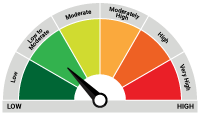Debt Monthly View for March 2023
Posted On Monday, Apr 10, 2023
In March, Indian bond yields eased by 5-20 basis points across the maturity curve. The benchmark 10-year government bond (Gsec) yield fell by 12 basis points to end the month at 7.31%.
The rally in the Indian bond market was primarily in response to a sharp drop in the US treasury yields. The 10-year US treasury yield fell by 42 basis points in March from 3.91% to 3.49% as financial stability concerns resurfaced in the US and Europe.
The failure of the Silicon Valley Bank and the Signature Bank in the US and the collapse of Credit Suisse in Europe triggered a global risk-off sentiment. It significantly lowered the rate hike probabilities in the advanced economies and fuelled a sudden bond rally. Indian bond yields followed global yields on the way down.
The short-term money market yields moved up sharply at the start of the month due to tax outflows and a lack of demand ahead of the financial year closing. However, rates came down sharply towards the month end as the year-end government spending eased liquidity in the banking system.
During the month, the yield on 3 months commercial papers (CPs) of AAA-rated PSUs fell from ~7.5% to 7.15%.
Monetary Policy
In the first bi-monthly monetary policy of FY24, the Monetary Policy Committee (MPC) of the RBI left the policy repo rate unchanged at 6.5%. Consequently, the SDF (Standing Deposit Facility) rate remained unchanged at 6.25%, and MSF (Marginal Standing Facility) rate at 6.75%
The policy stance is retained as ‘withdrawal of accommodation’ to ensure that inflation progressively aligns with the target while supporting growth. The RBI also lowered its CPI inflation estimate for FY24 from 5.3% to 5.2%; while keeping its GDP growth forecast the same at 6.5%.
The hawkish tone in the February policy statement and the surprise jump in Inflation in the last month had fuelled an expectation of a rate hike in this policy.
Thus, a ‘no rate hike’ was a positive surprise.
The governor made special efforts to sound hawkish by singling out this rate pause as a one-time deviation from its broader monetary policy path. Despite the use of Phrases like ‘for this meeting only’ and ‘a pause not pivot’, the bond market seems to have read it differently.
Bond yields fell by around 10 basis points post-policy announcement with the 10-year government bond yield falling below 7.2% intraday.
The governor made repeated references to the potential impact of the effective 290 basis points of rate increases in the last 1 year. This, along with the downward revision in inflation, indicates that the RBI has probably reached its destination in terms of the level of the Repo Rate and will hike rate only if the inflation path moves up significantly. The pause also seems to be driven by global financial stability issues.
Rate Outlook
Going ahead, the bond market should price for an extended rate pause with a terminal repo rate at 6.5%. This should open up space for Government bond yields to go down. We would expect the 10-year government bonds to trade between 7.00%-7.40%.
At a current yield of 7.2%, government bonds are now offering a positive real yield of about 200 basis points based on 4 quarter-ahead inflation estimate of 5.2%.
Also, with the rate hiking cycle nearing its end and inflation trending down, the probability of capital gains in long-term bonds has increased. Investors with over 2-3 years of investment horizon should allocate to dynamic bond funds which tend to benefit in this kind of interest rate environment.
Dynamic bond funds have the flexibility to change the portfolio positioning as per the evolving market conditions. This makes dynamic bond funds better suited for long-term investors in this volatile macro environment.
Investors with shorter investment horizons and low-risk appetite should stick with liquid funds. Tightening liquidity conditions will continue to put upward pressure on short-term rates and is in turn positive for short-term debt fund categories like the liquid fund. We would expect further improvement in the return potential of these categories as interest accrual on short-term debt instruments has risen meaningfully.
Since the interest rate on bank saving accounts are not likely to increase quickly while the returns from the liquid fund are already seeing an increase, investing in liquid funds looks more attractive for your surplus funds.
Investors with a short-term investment horizon and with little desire to take risks should invest in liquid funds which own government securities and do not invest in private sector companies which carry lower liquidity and higher risk of capital loss in case of default.
Source: RBI
| Name of the Scheme | This product is suitable for investors who are seeking* | Riskometer |
| Quantum Dynamic Bond Fund An Open-ended Dynamic Debt Scheme Investing Across Duration. A relatively high interest rate risk and relatively low credit risk. | • Regular income over short to medium term and capital appreciation • Investment in Debt / Money Market Instruments / Government Securities |  Investors understand that their principal will be at Low to Moderate Risk |
*Investors should consult their financial advisers if in doubt about whether the product is suitable for them.
| Potential Risk Class Matrix – Quantum Dynamic Bond Fund | |||
| Credit Risk → | Relatively Low | Moderate (Class B) | Relatively High (Class C) |
| Interest Rate Risk↓ | |||
| Relatively Low (Class I) | |||
| Moderate (Class II) | |||
| Relatively High (Class III) | A-III | ||
Disclaimer, Statutory Details & Risk Factors:The views expressed here in this article / video are for general information and reading purpose only and do not constitute any guidelines and recommendations on any course of action to be followed by the reader. Quantum AMC / Quantum Mutual Fund is not guaranteeing / offering / communicating any indicative yield on investments made in the scheme(s). The views are not meant to serve as a professional guide / investment advice / intended to be an offer or solicitation for the purchase or sale of any financial product or instrument or mutual fund units for the reader. The article has been prepared on the basis of publicly available information, internally developed data and other sources believed to be reliable. Whilst no action has been solicited based upon the information provided herein, due care has been taken to ensure that the facts are accurate and views given are fair and reasonable as on date. Readers of this article should rely on information/data arising out of their own investigations and advised to seek independent professional advice and arrive at an informed decision before making any investments. Mutual fund investments are subject to market risks read all scheme related documents carefully. |
Related Posts
-

Debt Monthly for December 2025
Posted On Tuesday, Dec 02, 2025
As we approach the end of the calendar year, we find ourselves at a pivotal moment, with the market split on the likelihood of an upcoming rate cut.
Read More -

Debt Monthly for November 2025
Posted On Tuesday, Nov 04, 2025
October 2025 in a Nutshell: Monetary Policy and Demand–Supply
Read More -

Debt Monthly for October 2025
Posted On Friday, Oct 03, 2025
September was a pivotal month for fixed income markets, both globally and domestically.
Read More



